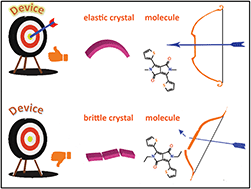Elastic organic semiconducting single crystals for durable all-flexible field-effect transistors: insights into the bending mechanism†
Abstract
Although many examples of mechanically flexible crystals are currently known, their utility in all-flexible devices is not yet adequately demonstrated, despite their immense potential for fabricating high performance flexible devices. Here, we report two alkylated diketopyrrolopyrrole (DPP) semiconducting single crystals, one of which displays impressive elastic mechanical flexibility whilst the other is brittle. Using the single crystal structures and density functional theory (DFT) calculations, we show that the methylated diketopyrrolopyrrole (DPP-diMe) crystals, with dominant π-stacking interactions and large contributions from dispersive interactions, are superior in terms of their stress tolerance and field-effect mobility (μFET) when compared to the brittle crystals of the ethylated diketopyrrolopyrrole derivative (DPP-diEt). Periodic dispersion-corrected DFT calculations revealed that upon the application of 3% uniaxial strain along the crystal growth (a)-axis, the elastically flexible DPP-diMe crystal displays a soft energy barrier of only 0.23 kJ mol−1 while the brittle DPP-diEt crystal displays a significantly larger energy barrier of 3.42 kJ mol−1, in both cases relative to the energy of the strain-free crystal. Such energy–structure–function correlations are currently lacking in the growing literature on mechanically compliant molecular crystals and have the potential to support a deeper understanding of the mechanism of mechanical bending. The field effect transistors (FETs) made of flexible substrates using elastic microcrystals of DPP-diMe retained μFET (from 0.019 cm2 V−1 s−1 to 0.014 cm2 V−1 s−1) more efficiently even after 40 bending cycles when compared to the brittle microcrystals of DPP-diEt which showed a significant drop in μFET just after 10 bending cycles. Our results not only provide valuable insights into the bending mechanism, but also demonstrate the untapped potential of mechanically flexible semiconducting crystals for designing all flexible durable field-effect transistor devices.

- This article is part of the themed collections: #MyFirstChemSci 2023 and 2023 Chemical Science Covers


 Please wait while we load your content...
Please wait while we load your content...